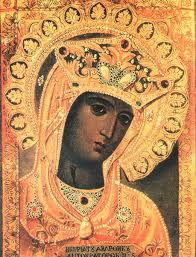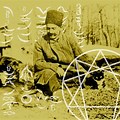Sacred Mysteries: The structural honesty of the Last of the Goths










Sacred Mysteries: The structural honesty of the Last of the Goths
here was quite a hoo-ha over the rebuilding of the chapel of Tonbridge School after its destruction by fire in 1988. The architect of its rebuilding, Donald Buttress, called it “a messy and very damaging affair”.

That phrase came in a letter in 1992 to Kenneth Powell (at the time architectural correspondent of this newspaper, and widely known for his work with Save Britain’s Heritage). Now Powell has written a study of Buttress’s life and work that elucidates the controversy. Buttress, now 90, was at Westminster Abbey (of which he was Surveyor of the Fabric for more than a decade) to see the book launched after a service of choral Evensong.
Among the pejorative terms thrown at Buttress during the rebuilding of Tonbridge School Chapel was “Modernist”. It is true that he used modern materials for the new roof above the old brick walls, all that were left from the Edwardian chapel of 1902.
The new wooden roof was given steel beams, grey-blue with red detailing. Above internal stone wall-shafts, steel “upswingers” – horn-shaped bundles of curved metal rods – secure the roof ties. Halfway down the nave, from two pairs of roof beams, hang inverted triangular steel frames. These support six-foot chandeliers suspended from the roof ridge and also stiffen the roof to support an external roof turret topped by a cupola and flèche.
Buttress had not wanted to replicate the roof spirelet lost in the fire. For one thing, it would be expensive. He wanted to extend an existing stair turret at one corner to accommodate a bell-cote. But he adjusted his plans. The leadwork of the new roof turret was to win an award for its craftsmanship. Indeed, the whole chapel possesses the spirit of Arts and Crafts. Buttress believed the chapel embodied much of his architectural credo: “directness, structural honesty and expression, rooted in history but definitely of its own time”.
Powell narrates an early passage in the architect’s life to explain his conviction that “all great Gothic buildings are capable of growth and enrichment”. Buttress did his National Service at St Athan, Glamorgan. Not far away was Llandaff Cathedral, badly damaged by bombing, but in 1957 restored with a striking addition to the nave. It was a great concrete parabola arch, allowing sight of the east end, but acting like a medieval pulpitum or stone screen. On this arch stood a vertical cylinder on which was fixed a sculpted figure of Christ in Majesty by Jacob Epstein. The architect responsible for this was George Pace (1915-75). Buttress thought it a 20th-century masterpiece.
When Buttress became Surveyor to the Fabric of Chichester Cathedral in 1985, he took Pace’s ideas with him. Though a conservationist, he agreed with Pace’s opposition to “arid preservationism which ignored liturgical and aesthetic issues” in Powell’s words. Buttress sometimes found it hard to accept that the shape of church buildings should be decided by secular elements in the conservation lobby. While surveyor, Buttress contributed to a beguiling little book on the collapse of Chichester spire in 1861. His years at the cathedral are commemorated by a carved gargoyle.
As Surveyor of the Fabric of Westminster Abbey, 1988-99, Buttress restored the exuberantly Perpendicular Henry VII’s Chapel, replacing more than 300 of its carved elements, many the decayed work of Thomas Gayfere, the early 19th-century master mason. Here and elsewhere Buttress formed part of a long tradition and did not repudiate the sobriquet accorded him as “the Last of the Goths”.
‘Shame!’: Tourist pelted with water by angry mob after climbing sacred Mayan temple











‘Shame!’: Tourist pelted with water by angry mob after climbing sacred Mayan temple
A tourist was pelted with water and booed loudly by locals after she climbed a sacred, off-limits Mayan temple.

The woman was filmed by bystanders scaling the enormous El Castillo (also known as the Temple of Kukulcán), a Mesoamerican step-pyramid at the Chichen Itza archaeological site in Mexico.
In the video, a blonde woman is seen dancing at the top of the steps as a security guard begins the long climb to remove her from the landmark.
By the time she was brought to the base of the pyramid, a crowd had gathered to boo, shout at and film her, chanting “jail, jail, jail” in unison.
A security guard tried to hold the mob back but the woman can be seen flinching as the crowd throws water at her in the clip.
The video has had more than 4.3 million views at the time of writing, with @angelalopeze, who posted it to TikTok, writing: “This is so disrespectful... don’t mess with my Mexican people.”
In a follow-up video posted to Twitter, bystanders are seeing grabbing the woman’s hair and throwing water at her as she tries to walk away from the mob.
The pyramid, which was constructed between the 8th and 12th centuries AD, has been off-limits to tourists since 2006; they may walk around it and photograph it but are forbidden from climbing or walking up it.
It had deep spiritual significance for the pre-Columbian Mayan people, and is one of the “New Seven Wonders of the World”.
The name and nationality of the offending tourist has not been identified, but she appears to be wearing a US flag motif on her T-shirt.
Unimpressed TikTok and Twitter users were quick to comment on the spectacle.
“There are human remains inside there. It’s like dancing on top of a grave. The disrespect,” wrote one commenter on TikTok.
“Imagine if someone climbed up on the altar in a cathedral and did a rude dance – this pyramid is sacred and that’s what she did,” said another.
“I instantly feel happy that everyone there wasn’t having it and rightfully boo’d her off,” wrote another.
Meanwhile, one Twitter user referenced a Game of Thrones episode, posting a video with the caption: “The Game of Thrones (2011) Season 5 finale, ‘Mother’s Mercy’”.
They drew comparisons with the famous “Cersei Lannister’s walk of atonement” scene, where the character is forced to walk naked through the town while onlookers jeer at her, shouting “Shame!” while they pelt her with rubbish.
A few people defended the woman, saying she may not have understood the rules.
“The way they react is horrible. The tourist was obviously wrong, apply a fine, but the aggression is absolutely unnecessary,” wrote one Spanish-speaking follower.
Another user responded by posting photos of the woman jumping over clear barriers at the base of the pyramid before climbing it.
A third replied: “It’s been off limits for over a decade… absolutely no excuse.”
Pope compares Russia's war in Ukraine to 1930s famine inflicted by Stalin










Pope compares Russia's war in Ukraine to 1930s famine inflicted by Stalin
VATICAN CITY (Reuters) - Pope Francis said on Wednesday that Ukrainians were suffering today from the "martyrdom of aggression" and compared Russia's war in Ukraine to the "terrible genocide" of the 1930s, when Soviet leader Josef Stalin inflicted famine on the country.
Francis, speaking to thousands of people in St. Peter's Square in his weekly general audience, mentioned the "Holodomor", or death by starvation, in which millions of Ukrainians died.
"This Saturday marks the anniversary of the terrible genocide of the Holodomor, the extermination by famine of 1932-33 that was artificially caused by Stalin," he said.
"Let us pray for the victims of this genocide and let us pray for so many Ukrainians - children, women, elderly - who are today suffering the martyrdom of aggression," he said.
For hundreds of years, the Ukrainian language and any expression of Ukrainian culture and independent identity were quashed, first under the Russian Empire of the tsars and later by the Soviets.
The Holodomor was a result of Stalin's efforts to collectivise agriculture and root out Ukraine's fledgling nationalist movement.
Since Russia invaded its neighbour in February, Francis has mentioned Ukraine in nearly all his public appearances and has warned several times that the crisis risks triggering the use of nuclear weapons, with uncontrollable global consequences.
Last month the pope for the first time directly begged Russian President Vladimir Putin to stop the "spiral of violence and death" in Ukraine.
(Reporting by Philip Pullella; Editing by Alex Richardson and Gareth Jones) Reference: Story by By Philip Pullella •
Pope appoints Archbishop Claudio Gugerotti prefect of the office for the Oriental Churches









Pope appoints Archbishop Claudio Gugerotti prefect of the office for the Oriental Churches
he Pope has appointed Archbishop Claudio Gugerotti, who since July 2020 was the apostolic nuncio to Great Britain, prefect of the Holy See's Dicastery for the Oriental Churches, the Vatican press office said in a statement.

Gugerotti has thus taken the place of Argentine Cardinal Leonardo Sandri, who had presided since 2007 over the Vatican body responsible for relations with the Eastern Catholic Churches. Sandri turned 79 last November 18. Normally the retirement age at the Vatican is 75, so Cardinal Sandri has remained in office four years longer than expected.
Archbishop Gugerotti had already held several positions in the Holy See's Dicastery for the Oriental Churches before beginning his diplomatic career as nuncio to the Holy See. Born in 1955 and ordained a priest in 1982, he studied Oriental Theology and Liturgy at the Institute of Ecumenical Studies in Verona from 1982 to 1985. In 1985, he joined the Congregation for Oriental Churches and became its undersecretary in 1997. During those years, he also taught patristics and Armenian language at the Pontifical Oriental Institute.
In 2001, John Paul II appointed him nuncio to Georgia, Armenia and Azerbaijan; at that time, all three Caucasus regions had the same nuncio.
In 2011, he was appointed nuncio to Belarus by Benedict XVI and in 2015 he was appointed nuncio to Ukraine by Pope Francis. During his years at the nunciature in Kiev, he coordinated the 'Pope For Ukraine' project. In addition, he frequently went to conflict sites, where he also accompanied Cardinal Sandri on a 2017 trip.
In July 2020, Francis appointed him apostolic nuncio to the United Kingdom. However, he also sent him on a mission as his special envoy to Belarus, to unblock the situation of Archbishop Kondrusiewicz in Minsk, who had not been granted permission to return to Belarus. Gugerotti mediated with the Belarusian government, which finally granted Kondrusiewicz permission as diplomatic representative, which he left when he turned 75.
Gugerotti's appointment to the Dicastery for the Oriental Churches is a further step in the renewal of the Curia propitiated by Pope Francis. Currently, the Dicasteries for the Doctrine of the Faith and for Bishops are also governed by cardinals over the age of 75, so the Pope is also expected to appoint a new prefect in the coming weeks.
Reference: Story by Daniel Stewart
Articles-Latest
- Koran burning conviction sparks fury as blasphemy law 'returns to UK'
- Robert Francis Prevost - Pope Leo XIV
- Pope Francis' death follows recent health challenges. Here's what we know about how he died.
- Easter April 2025 - international Celebrations
- The Rule of the twelve psalms -Worthy is the Lamb
- Religion in Africa Before Christianity and Islam
- 6 The Origin of Yahweh
- Dumo Di Milano
- What Did the Crow Tribe Believe In: Discover The Beliefs!
- 7 Reasons Historic Christianity Rejects the Book of Enoch
- 8 Breathtaking Mountain Monasteries Around the World
- Ethiopian Bible is oldest and most complete on earth
- Muhammad Muhammad was a prophet and founder of Islam.
- World Day of the Poor – SVP Christmas Campaign 2024
- Pope Francis to open 5 sacred portals on Christmas Eve — for a ritual that’s never been done before
- The 144,000 in Revelation
- Over 73 dead bodies 'used for meditation', 600 crocs in a pond, found in two Thai temples
- Occultism: Western Occult Tradition
- What is a Mudra
- Blood Sacrifices: Ancient Rituals of Life and Death
Articles-Most Read
- Home
- Let There Be Light
- Plants that feel and Speak
- The Singing Forest
- The Singing Forest-2
- Introduction
- Meditation
- Using Essential Oils for Spiritual Connection
- Heaven Scent
- Plants that Feel and Speak-2
- Purification
- Making the Spiritual Connection
- Anointing
- Essential Oils: The unseen Energies
- The Sanctity of Plants
- The Aroma Of Worship - Introduction
- The Aroma Of Worship-Foreward
- Methods Of Use
- Spiritual Blending
- Handling and Storage






